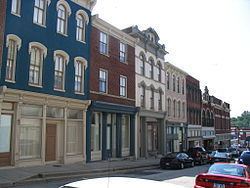Country United States Established 1792 Elevation 974 ft (297 m) Zip code 40353 Population 7,113 (2013) | Incorporated 1852 Time zone Eastern (EST) (UTC-5) Local time Monday 4:09 AM | |
 | ||
Weather -1°C, Wind SE at 10 km/h, 91% Humidity Points of interest Mt. Sterling, Montgomery County History Museum, Estill's Defeat Cemetery | ||
Mount Sterling – often written as Mt. Sterling – is a home rule-class city in Montgomery County, Kentucky, in the United States. The population was 6,895 at the 2010 U.S. census. It is the county seat of Montgomery County and the principal city of the Mount Sterling micropolitan area.
Contents
Map of Mt Sterling, KY 40353, USA
History
Mount Sterling is named for an ancient burial mound called Little Mountain, and for the town of Stirling in Scotland. It was named by the first developer of the area, Hugh Forbes. The Kentucky Assembly passed an act in 1792 establishing the town as Mt. Sterling, a misspelling which was retained.
The area was originally part of the thick wilderness of central Kentucky. Explorers, hunters, and surveyors traveling along a trail called Old Harper's Trace noted a 125-foot-high tree-covered mound which they called The Little Mountain. Later excavations showed it to be a burial site. The site of the mound is now the intersection of Queen and Locust streets in Mt. Sterling.
The first cabin in the area was built in 1779. The first permanent settlement was established around 1790, when Forbes began to sell lots and laid out a road, now Locust Street. In 1796 the town was established as the county seat of newly created Montgomery County. At that time the town consisted of 33 town lots, four retail stores, and three taverns. A courthouse was built, the first of seven to be housed in Mt. Sterling. A jail and a town pump were also installed. A large brick market house where farm produce was bought and sold confirmed the town as the commercial center of the surrounding area. Baptist, Presbyterian and Methodist churches were established during the town's first decade.
During the Civil War the town was occupied alternately by Union and Confederate troops on multiple occasions. The Battle of Mt. Sterling in June 1864, which ended in a Confederate defeat, was the last of the fighting in Montgomery County.
Geography
Mt. Sterling is located at 38°3′24″N 83°56′40″W (38.056613, -83.944500). According to the United States Census Bureau, the city has a total area of 3.4 square miles (8.8 km2), all land.
Demographics
As of the census of 2000, there were 5,876 people, 2,478 households, and 1,536 families residing in the city. The population density was 1,708.9 people per square mile (659.5/km²). There were 2,768 housing units at an average density of 805.0 per square mile (310.7/km²). The racial makeup of the city was 89.09% White, 8.73% African American, 0.22% Native American, 0.19% Asian, 0.75% from other races, and 1.02% from two or more races. Hispanic or Latino of any race were 1.68% of the population.
There were 2,478 households out of which 28.9% had children under the age of 18 living with them, 44.8% were married couples living together, 14.2% had a female householder with no husband present, and 38.0% were non-families. 33.3% of all households were made up of individuals and 17.4% had someone living alone who was 65 years of age or older. The average household size was 2.28 and the average family size was 2.89.
In the city, the population was spread out with 22.7% under the age of 18, 10.6% from 18 to 24, 28.4% from 25 to 44, 21.0% from 45 to 64, and 17.4% who were 65 years of age or older. The median age was 37 years. For every 100 females there were 86.0 males. For every 100 females age 18 and over, there were 83.1 males.
The median income for a household in the city was $27,050, and the median income for a family was $34,074. Males had a median income of $30,584 versus $21,081 for females. The per capita income for the city was $17,585. About 17.1% of families and 19.4% of the population were below the poverty line, including 29.4% of those under age 18 and 17.8% of those age 65 or over.
Culture
The Mt. Sterling–Montgomery County Library was established in 1871. The Mt. Sterling–Montgomery County Library moved to the current location, accessible from both Main and Locust Streets, in July 1984. The building was officially dedicated on September 30, 1984. The local library added a branch in Camargo in October, 2008.
Early Mount Sterling was the trading center for a vast part of Eastern Kentucky. It was the site of several prominent hotels, taverns, and theaters, which served as meeting places, entertainment sites, and stagecoach stops and mail depositories for post riders.
Beginning in the eighteenth century, Court Day quickly became the annual trading day for the area. It remains a big event today, held the third Monday in October and the weekend prior. Approximately 130,000 people from all parts of the country gather for the four-day event that specializes in many different arts and crafts, food and music.
Notable people
Climate
The climate in this area is characterized by hot, humid summers and generally mild to cool winters. According to the Köppen Climate Classification system, Mt. Sterling has a humid subtropical climate, abbreviated "Cfa" on climate maps.
